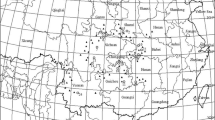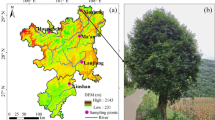Abstract
Withania somnifera (L.) Dunal is a promising herb with many pharmaceutical and therapeutic uses ranging from immunomodulation to anticarcinogenicity. It is commonly known as Indian ginseng, as it is comparable to Panax ginseng, which is a widely studied and utilized herb. There are limited studies on the genetic diversity of W. somnifera from the northeastern region of the Indian Subcontinent. This paper describes the characterization of wild accessions collected from Tamil Nadu State. A total of 15 accessions collected from wild populations were studied for their physical leaf traits such as leaf fresh weight (g), dry weight (mg), leaf dry matter content (mg g−1), specific leaf area (mm2 mg−1), leaf size (mm2), total carbon and nitrogen, and total withaferin-A content in leaves. An attempt was made to correlate physical leaf traits with withaferin-A content. The molecular traits, which were treated in a presence–absence matrix, failed to group the hyper-withaferin-A accessions. The quantified physical leaf traits were converted into a presence–absence matrix using a novel method of class-based stratification. The phenetic relations inferred from the Fitch–Margoliash algorithm applied to physical leaf trait data resulted in grouping of accessions with high withaferin-A content. These traits were used in the selection of promising accessions which can be further used for breeding programmes.












Similar content being viewed by others
References
Archana R, Namachivayam A (1999) Antistressor effect of Withania somnifera. J Ethnopharmacol 64:91–93
Axelius B (1996) The phylogenetic relationships of the Physaloid genera (Solanaceae) based on morphological data. Am J Bot 83(1):118–124
Bandyopadhyay M, Jha S, Tepfer D (2006) Changes in morphological phenotypes and withanolide composition of Ri-transformed roots of Withania somnifera. Plant Cell Rep 26:599–605
Bindiya K, Kanwar K (2003) Random amplified polymorphic DNA (RAPDs) markers for genetic analysis in micropropagated plants of Robinia pseudoacacia L. Euphytica 132:41–47
Choi J-H, Jung H-Y, Kim H-S, Cho H-G (2000) PhyloDraw: a phylogenetic tree drawing system. Bioinformatics 16(11):1056–1058
Cornelissen JHC (1999) A triangular relationship between leaf size and seed size among woody species: allometry, ontogeny, ecology and taxonomy. Oecologia 118:248–255
Cornelissen JHC, Lavorel S, Garnier E, Diaz S, Buchmann N, Gurvich DE, Reich PB, Ter Steege H, Morgan HD, Van der Heijden MGA, Pausas JG, Poorter H (2003) A handbook for protocols for standardized and easy measurement of plant functional traits worldwide. Aust J Bot 51:335–380
Davis L, Girija K (2000a) Immunomodulatory activity of Withania somnifera. J Ethnopharmacol 71:193–200
Davis L, Girija K (2000b) Suppressive effect of cyclophosphamide-induced toxicity by Withania somnifera extract in mice. J Ethnopharmacol 62:209–214
De Carvalho VM, Marques RM, Lapenta AS, Machado MFPS (2003) Functional classification of esterases from leaves of Aspidoserma polyneuron M. Arg. (Apocynaceae). Genet Mol Biol 26(2):195–198
Dhar RS, Verma V, Suri KA, Sangwan RS, Satti NK, Kumar A, Tuli R, Qazi GN (2006) Phytochemical and genetic analysis in selected chemotypes of Withania somnifera. Phytochemistry 67:2269–2276
Ganzera M, Choudhary MI, Khan IA (2003) Quantitative HPLC analysis of withanolides in withanolides in Withania somnifera. Fitoterapia 74:68–76
Gower JC (1972) Measures of taxonomic distances and their analysis. In: Weiner JS, Huizinga J (eds) The assessment of population affinities in man. Clarendon, Oxford, pp 1–24
Jaccard P (1908) Nouvelles rescherches surla distribution florale. Bull Soc Vaudoise Sci Nat 44:223–270
Khan IA, Khanum A (1994) Fundamentals of biostatistics. Ukaaz, Hyderabad
Khanna PK, Kumar A, Ahuja A, Kaul MK (2006) Seed protein characterization for morphotypes identification in Withania somnifera (L.) Dunal. Ind J Plant Physiol 11(3):321–324
Kothari SK, Singh CP, Kumar YV, Singh K (2003) Morphology, yield and quality of ashwagandha (Withania somnifera L. Dunal) roots and its cultivation economics as influenced by tillage depth and plant population density. J Hortic Sci Biotechnol 78(3):422–425
Kumar A, Kaul MK, Bhan MK, Khanna PK, Suri KA (2007) Morphological and chemical variation in 25 collections of the Indian medicinal plant, Withania somnifera (L.) Dunal (Solanaceae). Genet Resour Crop Evol 54:655–660
Laemmli UK (1970) Cleavage of structural proteins during the assembly of the head of bacteriophage T4. Nature 227:680–685
Lowry OH, Rosebrough NJ, Farr AL, Randall RJ (1951) Estimation of protein from biological samples. J Biochem 19:32–65
Manjunatha BR, Virupakshi S, Naik GR (2003) Peroxidase isozyme polymorphism in popular sugarcane cultivars. Curr Sci 85(9):1347–1349
Martin JP, Bermejo JEH (2000) Genetic variation in the endemic and endangered Rosmarinus tomentosus Huber-Morath & Maire (Labiatae) using RAPD markers. Heredity 85:434–443
Mathur S, Kaur P, Sharma M, Katyal A, Singh B, Tiwari M, Chandra R (2004) The treatment of skin carcinoma, induced by UV B radiation, using 1-oxo-5b, 6b-epoxy-witha-2-enolide, isolated from the roots of Withania somnifera, in a rat model. Phytomedicine 11:52–460
Negi MS, Singh A, Lakshmikumaran M (2000) Genetic variation and relationship among and within Withania species as revealed by AFLP markers. Genome 43:975–980
Owais M, Sharad KS, Shehbaz A, Saleemuddin M (2005) Antibacterial efficacy of Withania somnifera (ashwagandha) an indigenous medicinal plant against experimental murine salmonellosis. Phytomedicine 12:229–235
Panigrahi J, Kumar DR, Mishra M, Mishra RP, Jena P (2007) Genomic relationships among 11 species in the genus Cajanus as revealed by seed protein (albumin and globulin) polymorphisms. Plant Biotechnol Rep 1:109–116
Rao CR (1952) Advanced statistical methods in biomedical research. John Wiley and Sons Inc., New York, p 390
Sadasivam S, Manickam A (1996) Biochemical methods, 2nd edn. New Age International, New Delhi
Sangwan RS, Chawrasiya ND, Misra LN, Lal P, Uniyal GC, Sharma R, Sangwan NS, Suri KA, Qazi GN, Tuli R (2004) Phytochemical variability in commercial herbal products and preparation of Withania somnifera (Ashwagandha). Curr Sci 86(3):461–465
Scartezzini P, Antognoni F, Conte L, Maxia A, Troi A, Poli F (2007) Genetic and phytochemical difference between some Indian and Italian plants of Withania somnifera (L.) Dunal. Nat Prod Res 21(10):923–932
Singh S, Kumar S (1998) The Indian Ginseng Ashwagandha. CIMAP, Lucknow
Trivedy RK, Goel PK, Trisal CL (1987) Practical methods in ecology and environmental sciences. Environmental, Karad
Westoby M, Falster DS, Moles AT, Vesk PA, Wright IJ (2002) Plant ecological strategies: some leading dimensions of variation between species. Annu Rev Ecol Syst 33:125–159
Acknowledgments
The authors acknowledge the University Grants Commission, New Delhi for financial support (F.No.33-174/2007 SR) and the Department of Science and Technology, New Delhi for supporting the PG and Research Department of Botany through the DST-FIST Program. Help rendered by Dr. S. Janarthanan, Associate Prof of Zoology, University of Madras is greatly acknowledged.
Author information
Authors and Affiliations
Corresponding author
Rights and permissions
About this article
Cite this article
Aslam, A., Mohamed Rafi, K., Kathiravan, K. et al. Class-based stratification matrix for physical leaf traits in phenetic relations of Withania somnifera (L.) Dunal accessions. Plant Syst Evol 288, 99–111 (2010). https://doi.org/10.1007/s00606-010-0316-z
Received:
Accepted:
Published:
Issue Date:
DOI: https://doi.org/10.1007/s00606-010-0316-z




